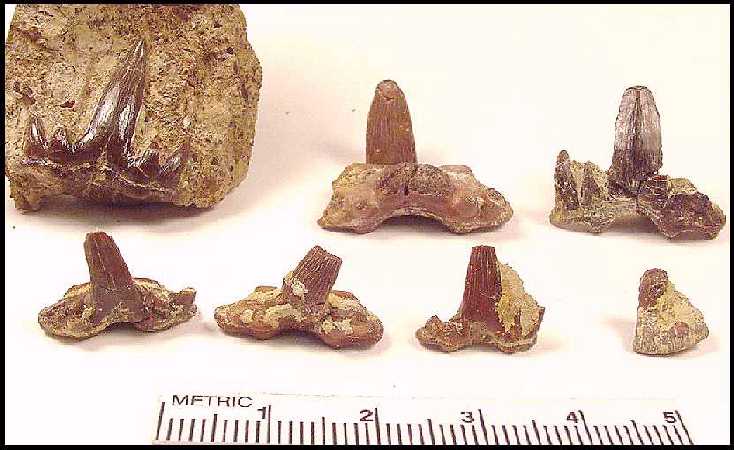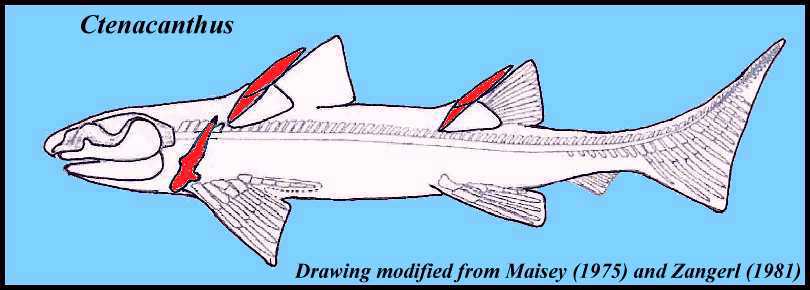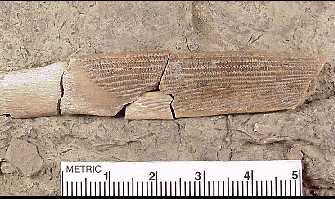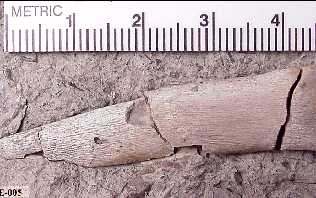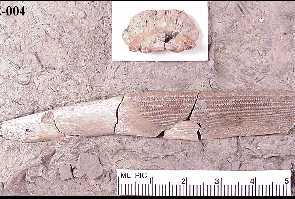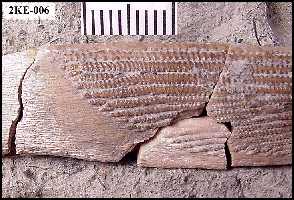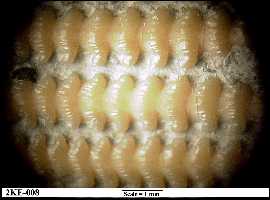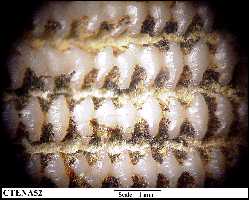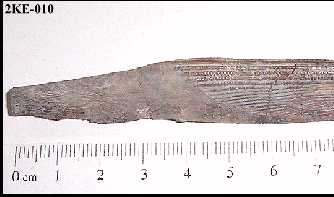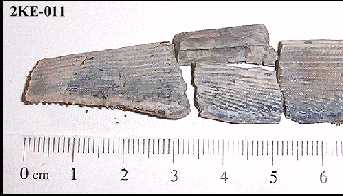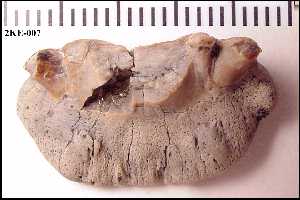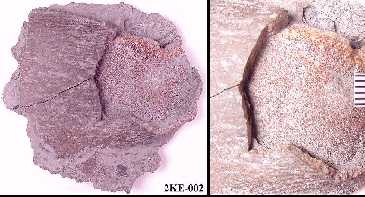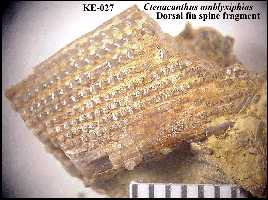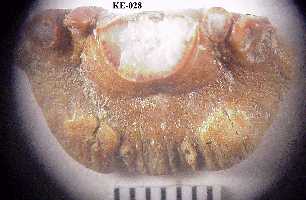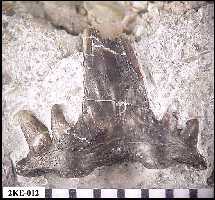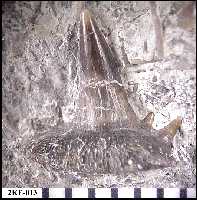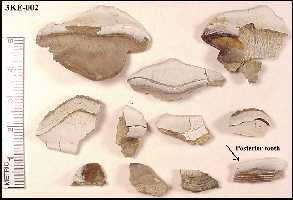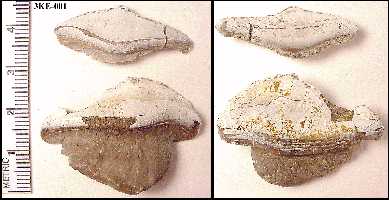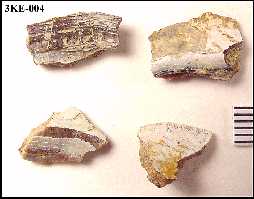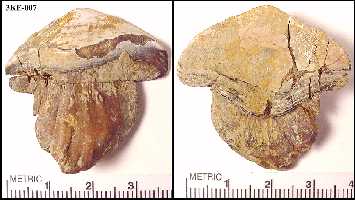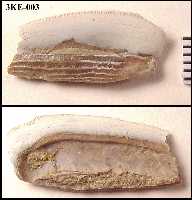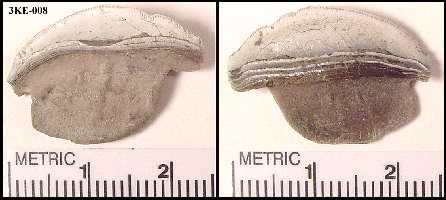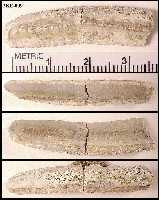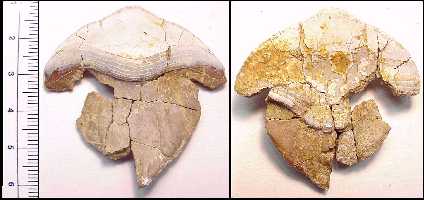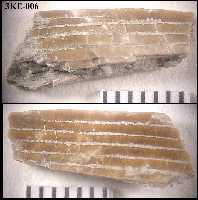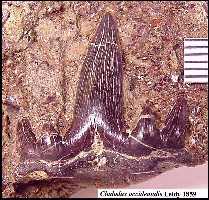 |
Left: Large Cladodus
occidentalis Leidy 1859 tooth in matrix, labial view. While these teeth are
often complete, the are also usually fractured. (KE-005) Right: Smaller Cladodus
occidentalis tooth (views: upper row, left to right - lingual,
labial, and occlusal; bottom row, left to right - lingual, lateral, lateral, and basal.
(KE-013) |
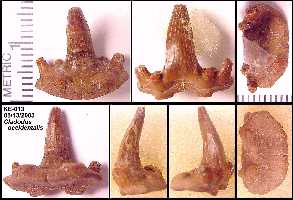 |
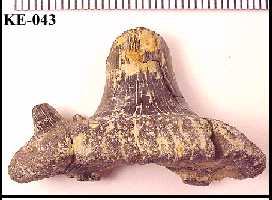 |
Left: Lingual and labial views of a very large Cladodus
sp. tooth (Base width = 36 mm). The crown and accessory cusps on this tooth exhibited a
lot of natural wear (KE-043). Right: Crown and basal views of a
slightly larger Cladodus sp. tooth (Base width = 38 mm) - (KE-042). |
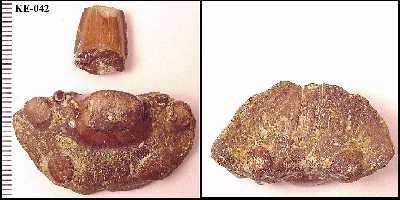 |
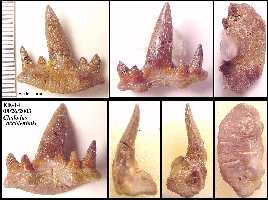 |
Left: A nice Cladodus occidentalis tooth
(KE-014). Click here for similar teeth in the
collection of the University of Kansas (KUVP 65013). Right: Large "Petalodus
alleghaniensis" (A) lingual view; B) labial view; C) occlusal view; D)
enlarged labial view - note "serrations" along cutting edge. Only a few Petalodus
teeth have been found at Site #1 (KE-016) |
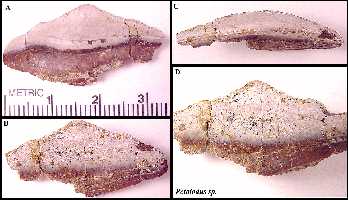 |
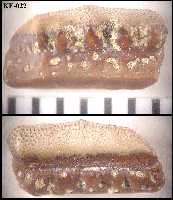 |
Left: Smaller teeth, possibly Orodus ?
(KE-022) Right: Acrodus ? ((KE-017) |
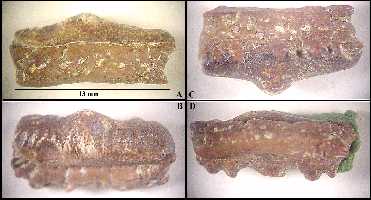 |
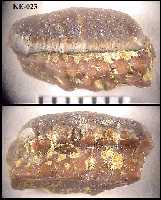 |
Left: Orodus ? (KE-023) Right:
Two Acrodus? teeth (KE-024) |
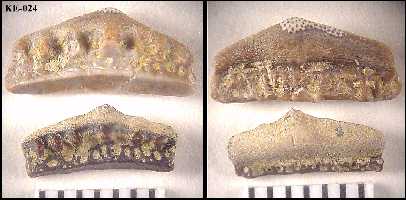 |
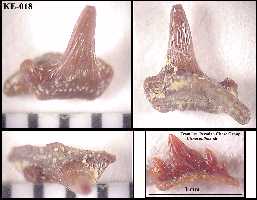 |
Left: Small cladodont tooth identified as "Maiseyodus
johnsoni" (unpublished species, Hansen, 1986). (KE-018). (Click here for a scan of Hansen's Figure 18 <WI> Right: A
small fragment from the upper end of a Ctenacanthus dorsal fin spine.
Note the characteristic denticles on the posterior edge of the spine. (KE-026) |
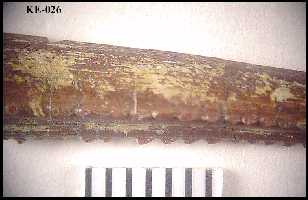 |
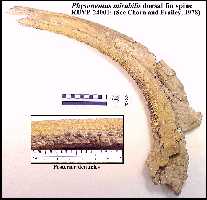 |
Left: A very large dorsal fin spine of Physonemus
mirabilis in right lateral view in the University of Kansas collection (Upper
Pennsylvanian - See Chorn and Frailey, 1978). The insert shows the detail of the posterior
denticles. (KUVP 25001) Right: A nearly complete dorsal fin
spine of Physonemus mirabilis (Xystracanthus arcuatus Leidy)
in right lateral view. Posterior denticles HERE. (KE-015) |
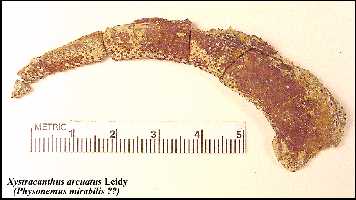 |
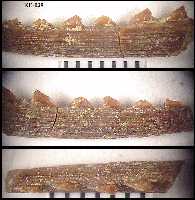 |
Left: An unusual spine with sharp,
teeth-like posterior denticles, the tips of which are broken in this specimen. Possibly
from the hybodont shark, Lissodus. (KE-039) <WI> Right:
A second specimen of the spine of the same organ genus exhibiting sharp posterior
denticles. (KE-040) |
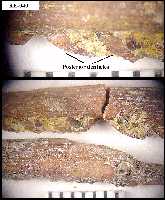 |
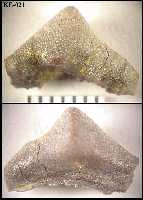 |
Left: These teeth are probably from Agassizodus
variabilis (corrugatus), a "Cestraciont" shark first described
from Kansas by Professor B. F. Mudge in 1874. (KE-021)
<MG> Right: As above (KE-029) |
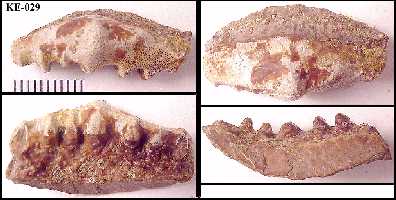 |
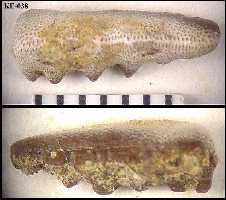 |
Left: These teeth are probably also from Agassizodus,
a "Cestraciont" shark first described from Kansas by Professor
B. F. Mudge in 1874. (KE-038) <MG> Right: As above
(KE-030) |
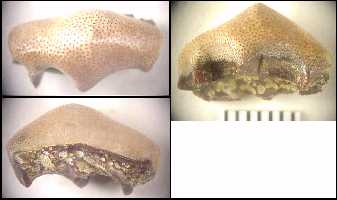 |
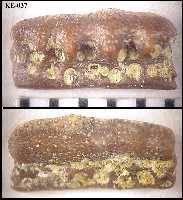 |
Left: These teeth are probably from Agassizodus,
a "Cestraciont" shark first described from Kansas by Professor
B. F. Mudge in 1874. (KE-037) <MG> Right: As above
(KE-032) |
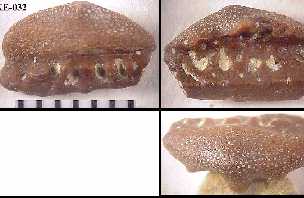 |
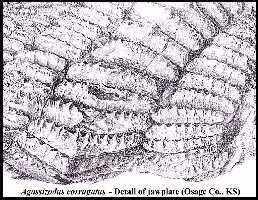 |
Left: Detail from Portion of Plate VIII (St.
John and Worthen, 1875) showing the Agassizodus corrugatus jaw plate
found in Osage County, Kansas. Right: Larger portion of Plate VIII
(St. John, and Worthen, 1875) showing the Agassizodus corrugatus jaw
plate from Osage County, Kansas. |
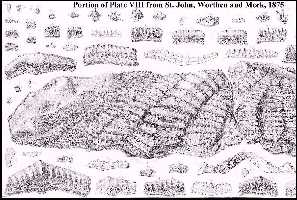 |
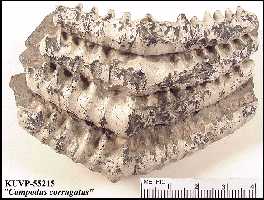 |
Left and Right: Two views of 4 teeth of Campodus
(Agassizodus) corrugatus teeth in natural articulation from University
of Kansas collection (KUVP 55215). Found by R. E. Fox in 1910 in the "Coal
measures." |
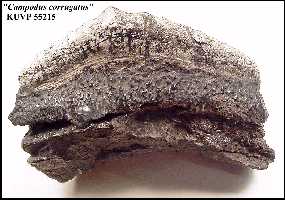 |
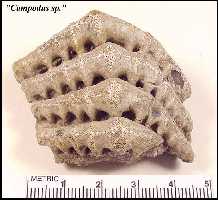 |
A second, articulated specimen of "Campodus"
found in the Pennsylvanian of Jefferson County, KS. (KU collection, found by J. Savage) |
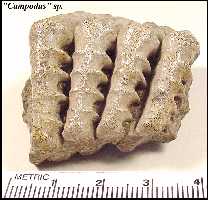 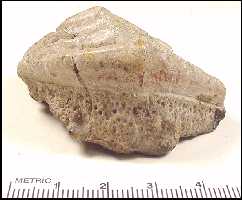 |
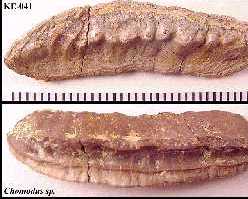 |
Left: A complete Chomodus sp. tooth
(KE-041). Right: Unknown tooth fragment, probably Chomodus.
(KE-033)
Far Right: Unknown tooth fragment (KE-025) |
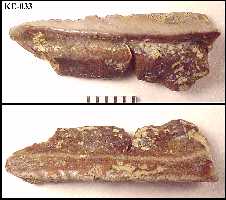 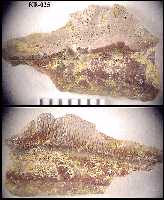 |
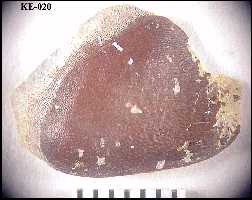 |
Left: Sandalodus (Deltodus)? Tooth
crown fragment. Note that this tooth is from a chimaeroid fish. Chimaeras, or
Ratfishes are cartilaginous fishes, but are not sharks. (KE-020)
Right:
Detail of calcified cartilage. (KE-034)
|
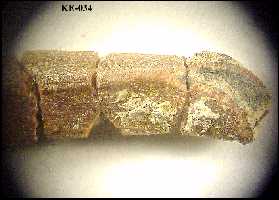 |
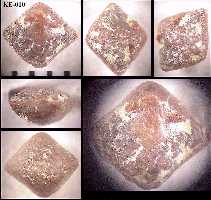 |
Left: Holmesella quadrata scale. (KE-010)
<DC> Right: Two Holmesella quadrata scales. This genus
was previously reported by Ørvig (1966) from Upper Pennsylvanian rocks in Montgomery Co.,
Kansas) (KE-019) |
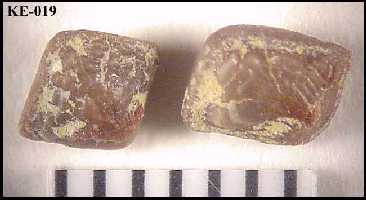 |
Site 3 - Geary County #2: This is another of Keith's sites, below Site 2 but somewhat
higher in the section than Site 1 (still lower Permian). This site has numerous Petalodus
teeth, but few teeth of other species.
Leidy, J. 1859. [Xystracanthus,
Cladodus and Petalodus from the Carboniferous of Kansas]. Proc.
Acad. Nat. Sci. Phila., 11:3.
Maisey, J.G. 1975. The interrelationships of phalacanthous selachians. N. Jb.
Geol. Paläont. Mh. 9:553-567, 6 fig.
Maisey, J.G. 1977. Structural notes on a cladoselachian dorsal spine. N. Jb.
Geol. Paläont. Mh. 1:47-55, 6 fig.
Maisey, J.G. 1982. Studies on the Paleozoic selachian genus Ctenacanthus
No. 2. Bythiacanthus St. John and Worthen, Amelacanthus St. John and
Worthen, Sphenacanthus Agassiz, and Wodnika Münster. American Museum
Noviates, 2722:1-24.
Maisey, J.G. 1984. Studies on the Paleozoic selachian genus Ctenacanthus
Agassiz. No. 3.: Nominal species referred to Ctenacanthus. American Museum
Noviates, 2774:1-20.
Mazzullo, S.J., C.S. Teal, and C. A. Burtnett. 1997. Outcrop stratigraphy and
depositional facies of the Chase Group (Permian, Wolfcampian) in Kansas and southeastern
Nebraska. Kansas Geological Survey Technical Series 6, 210 p.
Mudge, B. F. 1874. Rare forms of fish in Kansas.
Kansas Acad. Sci. Trans. 3:121-122 (Agassizodus tooth plate)
Ørvig, T. 1966. Histological studies of Ostracoderms, Placoderms, and fossil
Elasmobranchs. 2. On the dermal skeleton of two late Palaeozoic Elasmobranchs. Ark. Zool.
Stockholm. 19(1):1-39.
Robb, A.J. 2003. Notes on the occurrence of some petalodont shark fossils from
the Upper Pennsylvanian rocks of northeastern Kansas. Kansas Academy of Science,
Transactions 106(1-2):71-80.
Romer, A.S. 1942. Notes on certain American Paleozoic fishes. American
Journal of Science, 240:216-228, 1 pl.
Schultze, H-P. 1985. Marine to onshore
vertebrates in the Lower Permian of
Kansas
and their paleoenvironmental implications.
University
of
Kansas
, Paleontological Contributions, Paper 113:1-18.
Schultze, H.-P., J. D. Stewart, A. M. Neuner and R. W. Coldiron, 1982. Type and
figured specimens of fossil vertebrates in the collection of the University of Kansas
Museum of Natural History. Part I. Fossil fishes. Misc. Pub. Univ. Kansas Mus. Nat.
Hist. 73:53 pp. (see p. 5 for a listing of Holmesella sp. scales from the
Pennsylvanian of Kansas) <EM>
St. John, O.A. and H. Worthen. 1875. Palæontology: Descriptions of fossil
fishes. Geology and Palæontology, Part 2, Section 1, Geological Survey of Illinois,
6:245-532, i-vi, pl. 1-22.
Zangerl, R. 1981. Chondrichthyes I - Paleozoic Elasmobranchii. 3a:1-115 In
Shultze, H-P. (ed.), Handbook of Paleoichthyology. Gustav Fischer Verlag, Stuttgart and
New York.
Zidek, J. 1976. Oklahoma Paleoichthyology Part V: Chondrichthyes. Oklahoma
Paleontology Notes, 36(5):175-192, Oklahoma Geol. Surv., Norman, OK.
Credits: I thank Keith Ewell for the loan of these specimens and the
opportunity to learn more about Paleozoic sharks. David Cicimurri (Clemson
University), Michal Ginter (University of Warsaw, Poland), Mike Hansen (Ohio Geological
Survey), Wayne Itano ( NIST, Boulder, CO), John Maisey (American Museum of Natural
History), Earl Manning (Tulane University), Bill May (Sam Noble Museum, Norman, OK), and
Kenshu Shimada (DePaul University) have assisted in the identifications and/or provided
reference material.

